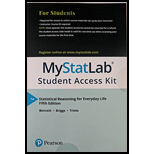
Germs. In a Wakefield Research survey, 1003 subjects were asked if they ever hesitated to give a handshake because of a fear of germs. Of these respondents, 41.0% answered “yes.”
- a. What is the number of respondents who answered “yes”?
- b. If 24 of the respondents said that they were not sure, what is the percentage of “not sure” responses?
- c. Given that the possible responses are “yes,” “no,” and “not sure,” are the data considered quantitative or qualitative? What is the level of measurement of those responses (nominal, ordinal, interval, or ratio)?
- d. Given that the survey was sponsored by Purell, a manufacturer of hand sanitizer products, is there any reason to question the results?
a.
Find the number of respondents who answered “yes”.
Answer to Problem 1CRE
The number of respondents who answered “yes” is 412.
Explanation of Solution
Calculation:
In a Wakefield Research survey, of 1,003 subjects 41% said “yes” for the question “if ever hesitated to give handshake because of a fear of germs”.
Denote x as the actual number of respondents.
The actual number of respondents is:
Thus, the actual number of respondents is 412.
b.
Find the percentage of respondents who answered “not sure”.
Answer to Problem 1CRE
The percentage of respondents who answered “not sure” is 2.4%.
Explanation of Solution
Calculation:
The of the respondents said that they were not sure.
The percentage of respondents who answered “not sure” is:
Thus, the percentage of respondents who answered “not sure” is 2.4.
c.
State whether the data considered as quantitative or qualitative.
Identify the measurement level as nominal, ordinal, interval or ratio for the given responses.
Answer to Problem 1CRE
The data is considered as qualitative.
The level of measurement is nominal.
Explanation of Solution
The given responses are, “yes”, “no” and “not sure”.
Qualitative data:
Qualitative data are those in which the data values contains non-numerical entries or categories such as gender, eye color, left handed or right handed etc.
Quantitative data:
Quantitative data are basically numerical values and those values are the representation of counts or measurements.
Here, the given data is qualitative because the responses are categorical and non-numeric. That is, the given responses, “yes”, “no” and “not sure” are not counted or measured.
Thus, the data is considered as qualitative.
Nominal measurement:
Nominal measurement is the most basic form of measurement that names or categorizes or classifies data. It is the weakest and easiest form of measurement.
Ordinal measurement:
Ordinal measurement is the measurement that ranks the data in a logical manner. It can be used when a natural ordering is present in the data to give the relative position of one object with respect to another. Numerical values can be assigned to the orders of the data, even when the data values are not naturally numerical. The properties of nominal measurement are applicable for ordinal measurement.
Interval measurement:
Interval measurement is the measurement that can be applied to data that naturally occur in the numerical form and counting of these values is logical. This scale of measurement does not have a meaningful “zero” value. However, the difference between any two points on the scale is meaningful. The operations of addition and subtraction on this scale are meaningful. The properties of nominal and ordinal measurements are applicable for interval measurement.
Ratio measurement:
Ratio measurement is the strongest form of measurement that can be applied to data that naturally occur in the numerical form and counting of these values is logical. This scale of measurement has a meaningful “zero” value. The operations of addition, subtraction, multiplication and division on this scale are meaningful. The properties of nominal, ordinal and interval measurements are applicable for ratio measurement.
The responses of the individuals are categorized into “yes”, “no” and “not sure”. The responses cannot be ranked in any logical order.
Hence, the data has nominal measurement level.
d.
Explain whether there is any reason to question the obtained results.
Answer to Problem 1CRE
Yes, there is reason for the sponsor to question the obtained results.
Explanation of Solution
It is given that the survey was sponsored by Purell, a manufacturer of hand sanitizer.
The sponsor may have possibilities to have favorable results. Because somehow the sponsor may have the financial interest in the results obtained in favor to hand sanitizer products.
Want to see more full solutions like this?
Chapter 2 Solutions
MyLab Statistics with Pearson eText -- Standalone Access Card -- for Statistical Reasoning for Everyday Life (5th Edition)
Additional Math Textbook Solutions
Probability and Statistics for Engineering and the Sciences
Business Analytics
Introduction to Statistical Quality Control
Applied Statistics in Business and Economics
Statistics for Business & Economics, Revised (MindTap Course List)
Statistics: Informed Decisions Using Data (5th Edition)
 MATLAB: An Introduction with ApplicationsStatisticsISBN:9781119256830Author:Amos GilatPublisher:John Wiley & Sons Inc
MATLAB: An Introduction with ApplicationsStatisticsISBN:9781119256830Author:Amos GilatPublisher:John Wiley & Sons Inc Probability and Statistics for Engineering and th...StatisticsISBN:9781305251809Author:Jay L. DevorePublisher:Cengage Learning
Probability and Statistics for Engineering and th...StatisticsISBN:9781305251809Author:Jay L. DevorePublisher:Cengage Learning Statistics for The Behavioral Sciences (MindTap C...StatisticsISBN:9781305504912Author:Frederick J Gravetter, Larry B. WallnauPublisher:Cengage Learning
Statistics for The Behavioral Sciences (MindTap C...StatisticsISBN:9781305504912Author:Frederick J Gravetter, Larry B. WallnauPublisher:Cengage Learning Elementary Statistics: Picturing the World (7th E...StatisticsISBN:9780134683416Author:Ron Larson, Betsy FarberPublisher:PEARSON
Elementary Statistics: Picturing the World (7th E...StatisticsISBN:9780134683416Author:Ron Larson, Betsy FarberPublisher:PEARSON The Basic Practice of StatisticsStatisticsISBN:9781319042578Author:David S. Moore, William I. Notz, Michael A. FlignerPublisher:W. H. Freeman
The Basic Practice of StatisticsStatisticsISBN:9781319042578Author:David S. Moore, William I. Notz, Michael A. FlignerPublisher:W. H. Freeman Introduction to the Practice of StatisticsStatisticsISBN:9781319013387Author:David S. Moore, George P. McCabe, Bruce A. CraigPublisher:W. H. Freeman
Introduction to the Practice of StatisticsStatisticsISBN:9781319013387Author:David S. Moore, George P. McCabe, Bruce A. CraigPublisher:W. H. Freeman





